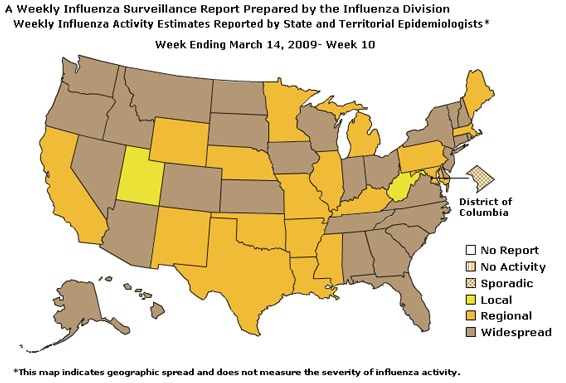Error processing SSI file
Weekly Report: Influenza Summary Update
2008-2009 Influenza Season Week 10 ending March 14, 2009
(All data are preliminary and may change as more reports are received.)Synopsis:
During week 10 (March 8-14, 2009), influenza activity decreased slightly in the United States.
- One thousand one hundred two (21.7%) specimens tested by U.S. World Health Organization (WHO) and National Respiratory and Enteric Virus Surveillance System (NREVSS) collaborating laboratories and reported to CDC/Influenza Division were positive for influenza.
- The proportion of deaths attributed to pneumonia and influenza (P&I) was below the epidemic threshold.
- Six influenza-associated pediatric deaths were reported.
- The proportion of outpatient visits for influenza-like illness (ILI) was above the national baseline. ILI decreased nationally and in eight of the nine regions compared to the previous week. Eight of nine surveillance regions reported ILI above their region-specific baselines.
- Thirty states reported widespread influenza activity, 18 states reported regional activity; two states reported local influenza activity; and Puerto Rico and the District of Columbia reported sporadic influenza activity.
Region |
Data for current week | Data cumulative for the season | ||||||
|---|---|---|---|---|---|---|---|---|
| Out-patient ILI* | % positive for flu?/strong> | Number of jurisdictions reporting regional or widespread activity?/strong> | A (H1) | A (H3) | A Unsub-typed | B | Pediatric Deaths | |
| Nation | Elevated | 21.7 % | 48 of 51 | 4895 | 492 | 8641 | 5797 | 32 |
| New England | Elevated | 17.7 % | 6 of 6 | 380 | 62 | 993 | 551 | 1 |
| Mid-Atlantic | Elevated | 23.6 % | 3 of 3 | 495 | 52 | 845 | 534 | 7 |
| East North Central | Elevated | 53.9 % | 5 of 5 | 814 | 58 | 133 | 523 | 2 |
| West North Central | Elevated | 22.2 % | 7 of 7 | 665 | 21 | 770 | 409 | 0 |
| South Atlantic | Elevated | 25.0 % | 7 of 9 | 872 | 52 | 1454 | 1224 | 3 |
| East South Central | Elevated | 19.5 % | 4 of 4 | 148 | 6 | 37 | 74 | 1 |
| West South Central | Normal | 20.0 % | 4 of 4 | 560 | 38 | 3462 | 2007 | 9 |
| Mountain | Elevated | 16.3 % | 7 of 8 | 444 | 124 | 634 | 164 | 7 |
| Pacific | Elevated | 17.8 % | 5 of 5 | 517 | 79 | 313 | 311 | 2 |
* Elevated means the % of visits for ILI is at or above the national or
region-specific baseline
† National data is for current week; regional data is for the most recent three weeks.
‡ Includes all 50 states and the District of Columbia
U.S. Virologic Surveillance:
WHO and NREVSS collaborating laboratories located in all 50 states and Washington D.C. report to CDC the number of respiratory specimens tested for influenza each week. The results of tests performed during the current week and cumulative totals for the season are summarized in the table below.
| Week 10 | Cumulative for the Season | |
|---|---|---|
| No. of specimens tested | 5,076 | 149,492 |
| No. of positive specimens (%) | 1,102 (21.7%) | 19,825 (13.3%) |
| Positive specimens by type/subtype | ||
| Influenza A | 522 (47.4%) | 14,028 (70.8%) |
| A (H1) | 107 (20.5%) | 4,895 (34.9%) |
| A (H3) | 13 (2.5%) | 492 (3.5%) |
| A (unsubtyped) | 402 (77.0%) | 8,641 (61.6%) |
| Influenza B | 580 (52.6%) | 5,797 (29.2%) |
Since week 2 (the week ending January 17, 2009), when influenza activity increased nationally, influenza A (H1) viruses have predominated during the season overall. However, the relative proportion of influenza B viruses is increasing nationally and regionally. While influenza activity slightly decreased nationally, several surveillance regions reported an increase in influenza virus circulation, and six regions (East North Central, Mid-Atlantic, New England, Pacific, South Atlantic, and West South Central) reported an equal or higher proportion of influenza B viruses compared to influenza A viruses this week.
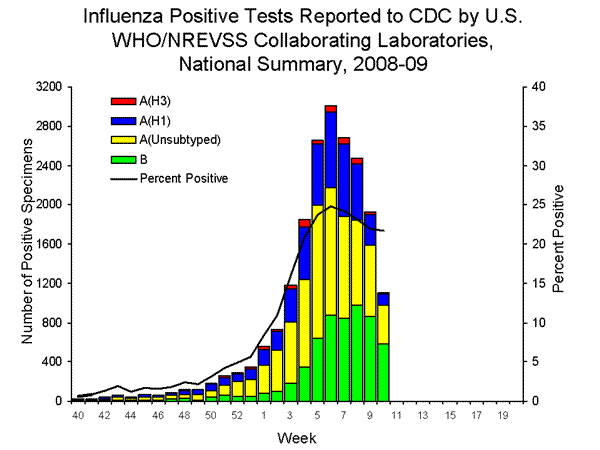
View WHO-NREVSS Regional Bar Charts| View Chart Data | View Full Screen
Composition of the 2009-10 Influenza Vaccine:
WHO has recommended vaccine strains for the 2009-10 Northern Hemisphere trivalent influenza vaccine, and FDA has made the same recommendations for the U.S. influenza vaccine. Both agencies recommend that the vaccine contain A/Brisbane/59/2007-like (H1N1), A/Brisbane/10/2007-like (H3N2), and B/Brisbane/60/2008-like (B/Victoria lineage) viruses. Only the influenza B component has been changed from the 2008-09 vaccine formulation. This recommendation was based on surveillance data related to epidemiology and antigenic characteristics, serological responses to 2008-09 vaccines, and the availability of candidate strains and reagents.
Antigenic Characterization:
CDC has antigenically characterized 702 influenza viruses [439 influenza A (H1), 53 influenza A (H3) and 210 influenza B viruses] collected by U.S. laboratories since October 1, 2008.
All 439 influenza A (H1) viruses are related to the influenza A (H1N1) component of the 2008-09 influenza vaccine (A/Brisbane/59/2007). All 53 influenza A (H3N2) viruses are related to the A (H3N2) vaccine component (A/Brisbane/10/2007).
Influenza B viruses currently circulating can be divided into two distinct lineages represented by the B/Yamagata/16/88 and B/Victoria/02/87 viruses. Forty-four influenza B viruses tested belong to the B/Yamagata lineage and are related to the vaccine strain (B/Florida/04/2006). The remaining 166 viruses belong to the B/Victoria lineage and are not related to the vaccine strain.
Data on antigenic characterization should be interpreted with caution given that antigenic characterization data is based on hemagglutination inhibition (HI) testing using a panel of reference ferret antisera and results may not correlate with clinical protection against circulating viruses provided by influenza vaccination.
Annual influenza vaccination is expected to provide the best protection against those virus strains that are related to the vaccine strains, but limited to no protection may be expected when the vaccine and circulating virus strains are so different as to be from different lineages, as is seen with the two lineages of influenza B viruses.
Antiviral Resistance:
Since October 1, 2008, 474 influenza A (H1N1), 77 influenza A (H3N2), and 227 influenza B viruses have been tested for resistance to the neuraminidase inhibitors (oseltamivir and zanamivir). Four hundred seventy-six influenza A (H1N1) and 77 influenza A (H3N2) viruses have been tested for resistance to the adamantanes (amantadine and rimantadine). The results of antiviral resistance testing performed on these viruses are summarized in the table below.
| Isolates tested (n) | Resistant Viruses, Number (%) |
Isolates tested (n) | Resistant Viruses, Number (%) | ||
|---|---|---|---|---|---|
| Oseltamivir | Zanamivir | Adamantanes | |||
| Influenza A (H1N1) | 474 | 469 (98.9%) | 0 (0) | 476 | 3 (0.6%) |
| Influenza A (H3N2) | 77 | 0 (0) | 0 (0) | 77 | 77 (100%) |
| Influenza B | 227 | 0 (0) | 0 (0) | N/A* | N/A* |
Influenza A (H1N1) viruses from 40 states have been tested for antiviral resistance to oseltamivir so far this season. To date, all influenza A (H3N2) viruses tested are resistant to the adamantanes and all oseltamivir-resistant influenza A (H1N1) viruses tested are sensitive to the adamantanes. Nationally, influenza A (H1N1) viruses have predominated during the season overall. While influenza activity slightly decreased nationally, the relative proportion of influenza B viruses is increasing. During week 10, influenza B viruses accounted for 50% or more of the influenza viruses identified nationally and in six of the nine surveillance regions. This presents challenges for the selection of antiviral medications for the treatment and chemoprophylaxis of influenza. Health care providers should be aware of the possibility of increased influenza B circulation in their area, and continue test patients for influenza and consult local surveillance data when evaluating patients with acute respiratory infections during the influenza season. CDC issued interim recommendations for the use of influenza antiviral medications in the setting of oseltamivir resistance among circulating influenza A (H1N1) viruses on December 19, 2008. These interim recommendations are available at http://www2a.cdc.gov/HAN/ArchiveSys/ViewMsgV.asp?AlertNum=00279
Pneumonia and Influenza (P&I) Mortality Surveillance
During week 10, 7.0% of all deaths reported through the 122-Cities Mortality Reporting System were due to P&I. This percentage is below the epidemic threshold of 8.0% for week 10.
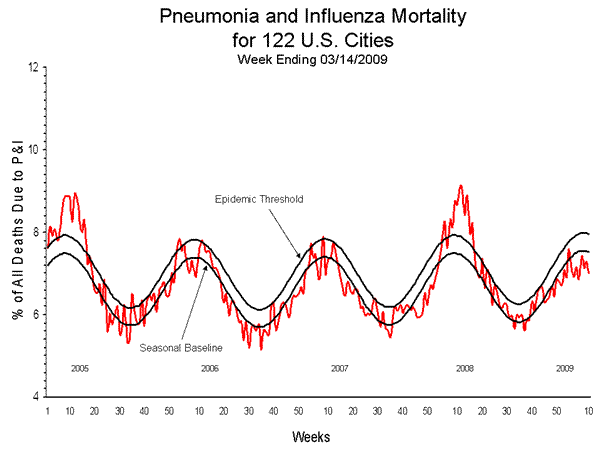
View Full Screen
Influenza-Associated Pediatric Mortality
Six influenza-associated pediatric deaths were reported to CDC during week 10 (Michigan, Nevada, New Jersey, New York, New York City, and Texas). The deaths reported this week occurred between February 15 and March 7, 2009. Since September 28, 2008, CDC has received 32 reports of influenza-associated pediatric deaths that occurred during the current season.
Of the 20 children who had specimens collected for bacterial culture from normally sterile sites, eight (40.0%) were positive; Staphylococcus aureus was identified in five (62.5%) of the eight children. Two of the S. aureus isolates were sensitive to methicillin and three were methicillin resistant. All eight children with bacterial coinfections were five years of age or older and seven (87.5%) of the eight children were 12 years of age or older. An increase in the number of influenza-associated pediatric deaths with bacterial coinfections was first recognized during the 2006-07 influenza season. In January 2008, interim testing and reporting recommendations were released regarding influenza and bacterial coinfections in children and are available at (http://www2a.cdc.gov/HAN/ArchiveSys/ViewMsgV.asp?AlertNum=00268).
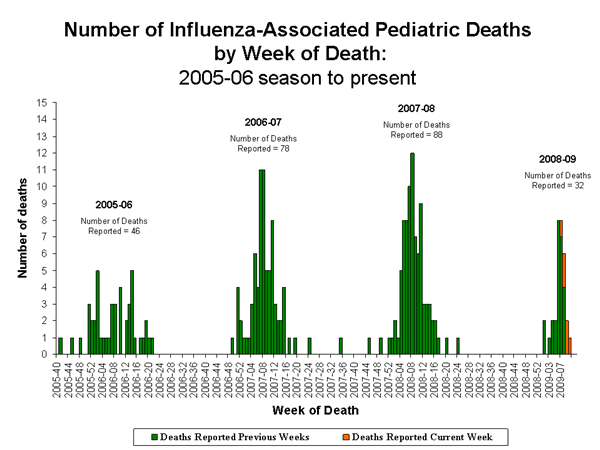
View Full Screen
Influenza-Associated Hospitalizations
Laboratory-confirmed influenza-associated hospitalizations are monitored in two population-based surveillance networks: the Emerging Infections Program (EIP) and the New Vaccine Surveillance Network (NVSN). These two systems provide updates of surveillance data every two weeks.
During October 12, 2008 to March 7, 2009, the preliminary laboratory-confirmed influenza-associated hospitalization rate for children 0-4 years old in the NVSN was 0.55 per 10,000. Due to case identification methods utilized in this study, a delay exists from the date of hospitalization to the date of report.
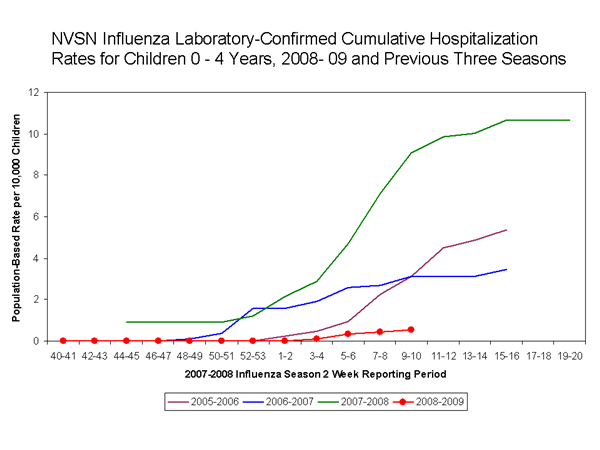
View Full Screen
During October 1, 2008 ?March 14, 2009, preliminary laboratory-confirmed influenza-associated hospitalization rates reported by the EIP for children aged 0-4 years and 5-17 years were 2.1 per 10,000 and 0.4 per 10,000, respectively. For adults aged 18-49 years, 50-64 years, and >= 65 years, the rates were 0.2 per 10,000, 0.3 per 10,000, and 0.8 per 10,000, respectively.

View Full Screen
Outpatient Illness Surveillance:
Nationwide during week 10, 2.9% of patient visits reported through the U.S. Outpatient Influenza-like Illness Surveillance Network (ILINet) were due to influenza-like illness (ILI). This percentage is above the national baseline of 2.4%.
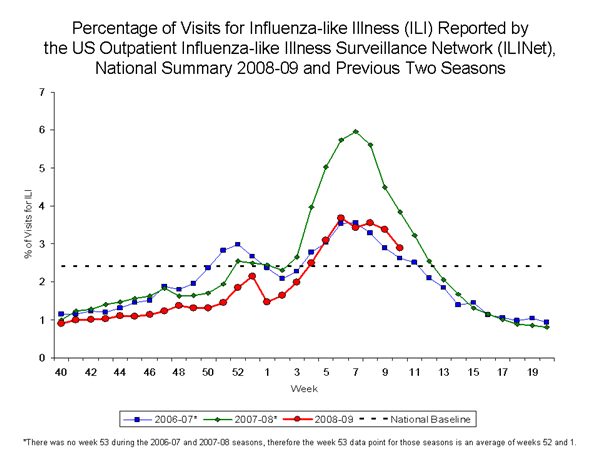
View Sentinel Providers Regional Charts | View Chart Data |View Full Screen
On a regional level, the percentage of visits for ILI decreased in eight of the nine regions (East North Central, East South Central, Mid-Atlantic, Mountain, New England, South Atlantic, West North Central, and West South Central) compared to the previous week and ranged from 1.7% to 4.0%. Eight of the nine surveillance regions reported ILI percentages above their region specific baselines.
| Region | New England | Mid- Atlantic | East North Central | West North Central | South Atlantic | East South Central | West South Central | Mountain | Pacific |
|---|---|---|---|---|---|---|---|---|---|
| Reported ILI (%) | 1.7 | 3.3 | 2.3 | 1.9 | 2.9 | 2.9 | 4.0 | 1.7 | 3.6 |
| Region-Specific Baseline | 1.5 | 2.9 | 1.9 | 1.7 | 2.2 | 2.5 | 4.8 | 1.5 | 3.0 |
Geographic Spread of Influenza as Assessed by State and Territorial Epidemiologists:
During week 10, the following influenza activity was reported:
- Widespread influenza activity was reported by 30 states (Alabama, Alaska, Arizona, Colorado, Connecticut, Delaware, Florida, Georgia, Hawaii, Idaho, Indiana, Iowa, Kansas, Montana, Nevada, New Hampshire, New Jersey, New York, North Carolina, North Dakota, Ohio, Oregon, Rhode Island, South Carolina, South Dakota, Tennessee, Vermont, Virginia, Washington, and Wisconsin).
- Regional influenza activity was reported by 18 states (Arkansas, California, Illinois, Kentucky, Louisiana, Maine, Maryland, Massachusetts, Michigan, Minnesota, Mississippi, Missouri, Nebraska, New Mexico, Oklahoma, Pennsylvania, Texas, and Wyoming).
- Local influenza activity was reported by two states (Utah and West Virginia).
- Sporadic activity was reported by Puerto Rico and the District of Columbia.
--------------------------------------------------------------------------------
A description of surveillance methods is available at: http://www.cy118119.com/flu/weekly/fluactivity.htm
- Page last updated March 20, 2009.
